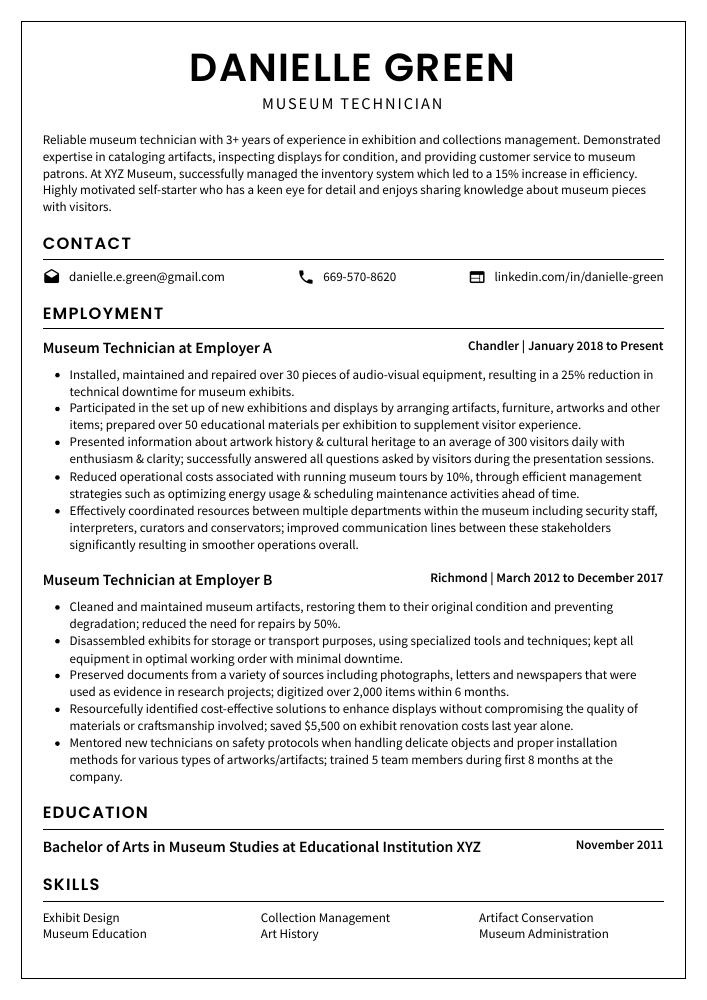Museum Technician Resume Guide
Museum Technicians are responsible for the maintenance and care of museum collections, including organizing, conserving, cataloguing and researching items. They also assist with exhibitions by setting up displays and providing information to visitors. In addition, they help create educational materials such as brochures or interactive exhibits.
You have the expertise to maintain and repair museum exhibits, but potential employers don’t know that yet. To get them up to speed on your knowledge and abilities, you must create an eye-catching resume that grabs their attention.
This guide will walk you through the entire process of creating a top-notch resume. We first show you a complete example and then break down what each resume section should look like.
Table of Contents
The guide is divided into sections for your convenience. You can read it from beginning to end or use the table of contents below to jump to a specific part.
Museum Technician Resume Sample
Danielle Green
Museum Technician
danielle.e.green@gmail.com
669-570-8620
linkedin.com/in/danielle-green
Summary
Reliable museum technician with 3+ years of experience in exhibition and collections management. Demonstrated expertise in cataloging artifacts, inspecting displays for condition, and providing customer service to museum patrons. At XYZ Museum, successfully managed the inventory system which led to a 15% increase in efficiency. Highly motivated self-starter who has a keen eye for detail and enjoys sharing knowledge about museum pieces with visitors.
Experience
Museum Technician, Employer A
Chandler, Jan 2018 – Present
- Installed, maintained and repaired over 30 pieces of audio-visual equipment, resulting in a 25% reduction in technical downtime for museum exhibits.
- Participated in the set up of new exhibitions and displays by arranging artifacts, furniture, artworks and other items; prepared over 50 educational materials per exhibition to supplement visitor experience.
- Presented information about artwork history & cultural heritage to an average of 300 visitors daily with enthusiasm & clarity; successfully answered all questions asked by visitors during the presentation sessions.
- Reduced operational costs associated with running museum tours by 10%, through efficient management strategies such as optimizing energy usage & scheduling maintenance activities ahead of time.
- Effectively coordinated resources between multiple departments within the museum including security staff, interpreters, curators and conservators; improved communication lines between these stakeholders significantly resulting in smoother operations overall.
Museum Technician, Employer B
Richmond, Mar 2012 – Dec 2017
- Cleaned and maintained museum artifacts, restoring them to their original condition and preventing degradation; reduced the need for repairs by 50%.
- Disassembled exhibits for storage or transport purposes, using specialized tools and techniques; kept all equipment in optimal working order with minimal downtime.
- Preserved documents from a variety of sources including photographs, letters and newspapers that were used as evidence in research projects; digitized over 2,000 items within 6 months.
- Resourcefully identified cost-effective solutions to enhance displays without compromising the quality of materials or craftsmanship involved; saved $5,500 on exhibit renovation costs last year alone.
- Mentored new technicians on safety protocols when handling delicate objects and proper installation methods for various types of artworks/artifacts; trained 5 team members during first 8 months at the company.
Skills
- Exhibit Design
- Collection Management
- Artifact Conservation
- Museum Education
- Art History
- Museum Administration
- Exhibit Installation
- Digital Archiving
- Cataloging
Education
Bachelor of Arts in Museum Studies
Educational Institution XYZ
Nov 2011
Certifications
Certified Museum Technician
American Association for State and Local History
May 2017
1. Summary / Objective
A resume summary for a museum technician should be concise and to the point, highlighting your most relevant skills and experience. For example, you could mention the number of years you have been working in museums, any specialized training or certifications you possess (such as conservation techniques), and how many artifacts/exhibits you have managed. Additionally, if there is something unique about your work history that makes it stand out from other applicants’, this would be an ideal place to highlight it.
Below are some resume summary examples:
Well-rounded museum technician with a passion for preserving history and providing the public with access to artifacts. Over 8 years of experience in museum curating, exhibiting, cataloging, archiving and restoration. Experienced in designing engaging exhibits that have drawn an increase in visitor attendance by 25%. Proven expertise in installing lighting systems as well as developing educational materials for visitors at XYZ Museum.
Accomplished museum technician with over 10 years of experience in the preservation and maintenance of artifacts. Experienced in cataloging, conservation and restoration techniques for various types of objects including paintings, sculptures, textiles and furniture. Adept at managing multiple projects simultaneously; recently coordinated a successful exhibit that featured more than 500 artifacts from around the world.
Professional museum technician with 5+ years of experience in archiving and preserving library materials. Skilled in cataloging, conducting research, and organizing collections for display at ABC Museum. Passionate about educating the public on cultural heritage through interactive exhibits and events. Seeking to apply advanced knowledge of museum techniques to aid curatorial staff in managing artifacts efficiently.
Amicable and detail-oriented museum technician with extensive experience in the curation, preservation, and display of artifacts. 7+ years of expertise utilizing specialized databases to track valuable items while managing a variety of projects simultaneously. Looking to join ABC Museum as their next technician and utilize my organizational skillset for the benefit of both visitors and staff alike.
Passionate museum technician with 5+ years of experience managing and preserving collections. Skilled in assessing, cataloguing, and digitizing artifacts according to museum standards. Experienced working with a variety of digital imaging software for restoration purposes. Looking to apply my knowledge at ABC Museum to create an engaging learning environment for visitors.
Talented museum technician with a degree in art history and four years of experience working with museum collections. Experienced in cataloguing, restoration, display setup and maintenance, conservation techniques, research projects and more. Committed to maintaining the highest standards in preserving valuable artifacts while providing excellent customer service.
Seasoned museum technician with 7+ years of experience in curating, researching and cataloging artifacts. Possesses an extensive knowledge base on world history and art that has been applied to numerous exhibitions at ABC Museum. Recognized for valuable contributions such as developing a new system for tracking inventory which reduced time spent searching by 50%.
Energetic and detail-oriented museum technician with 5+ years of experience managing and cataloging collections in a variety of institutions. Seeking to bring expertise to ABC Museum where I can utilize my knowledge and skills to further enhance the institution’s collection, develop new strategies for display, and create innovative educational programs.
2. Experience / Employment
In the experience section, you should provide details on your employment history. This section should be written in reverse chronological order, with the most recent job listed first.
Stick to bullet points when talking about what you did; this allows for easy digestion of information by the reader. When writing out each point, make sure to include detail and quantifiable results where possible. For example, instead of saying “Maintained museum artifacts,” you could say “Performed weekly maintenance checks on over 500 museum artifacts using a variety of cleaning materials.”
To write effective bullet points, begin with a strong verb or adverb. Industry specific verbs to use are:
- Installed
- Monitored
- Catalogued
- Restored
- Preserved
- Assembled
- Disassembled
- Operated
- Inspected
- Calibrated
- Repaired
- Cleaned
- Tested
- Adjusted
- Troubleshot
Other general verbs you can use are:
- Achieved
- Advised
- Assessed
- Compiled
- Coordinated
- Demonstrated
- Developed
- Expedited
- Facilitated
- Formulated
- Improved
- Introduced
- Mentored
- Optimized
- Participated
- Prepared
- Presented
- Reduced
- Reorganized
- Represented
- Revised
- Spearheaded
- Streamlined
- Structured
- Utilized
Below are some example bullet points:
- Accurately operated, maintained and repaired a variety of museum equipment including audio-visual systems, projectors and lighting fixtures; reduced repair time by 25% within first six months.
- Advised over 30 clients on proper handling techniques to preserve artifacts while conducting tours through the museum exhibits; increased customer satisfaction ratings by 15%.
- Operated cutting edge digitization technologies to accurately scan documents for archival purposes, resulting in successful preservation of 80+ pieces of rare manuscripts.
- Represented the institution at various public events (fairs, conferences) to promote its mission and programming initiatives as well as increase attendance rates by 10%.
- Introduced innovative educational programs that addressed topics such as history & culture studies with an aim to engage more than 300 visitors every month from different age groups into participating in interactive activities.
- Expedited set up of museum exhibitions, including painting walls, positioning artifacts and setting displays; completed projects with a 95% client satisfaction rating.
- Assembled props for display exhibits from drawings and schematics; constructed over 50 items within budget in the last year.
- Troubleshot equipment malfunctions across several digital audio/visual systems used to enhance visitor experience at museum sites; reduced downtime by 25%.
- Catalogued over 500 historic artifacts into detailed inventory records accurately and efficiently using specialized software programs; increased retrieval speed for staff members by 20%.
- Meticulously maintained lighting levels on an array of special effects throughout the facility to ensure optimal viewing conditions for visitors while preserving delicate artwork pieces without damage or fading – achieved energy savings of $1,000 annually due to improved efficiency standards.
- Utilized technical expertise to construct and assemble permanent exhibitions, displays and installations in the museum; reduced installation time by 20% with improved efficiency.
- Structured educational programs for students of all ages, providing guidance on proper handling techniques when viewing artifacts; raised public awareness about museum collections by 25%.
- Thoroughly inspected various pieces of equipment such as audio-visual systems, computers and lighting fixtures for signs of defects or malfunctions; identified potential problems before they occurred which saved $4,000 in repairs fees over a 6 month period.
- Spearheaded multiple conservation projects that included preserving documents from past civilizations as well as restoring artwork damaged due to natural disasters; restored 300+ items within 3 months at an average cost savings per item of 15%.
- Optimized operational processes related to cleaning artifacts while ensuring their safety through adherence to established protocols & standards; minimized damage or loss caused by mishandling exhibited items by 10%.
- Adjusted exhibit components, including lighting and audio-visual equipment, in order to maintain aesthetic presentation of museum artifacts; improved the overall appearance of displays by 25%.
- Restored over 40 historic artifacts through careful research and conservation efforts, increasing museum collection value by $50,000.
- Achieved preservation goals for delicate paintings and sculptures prior to their display in the gallery space within 3 hours on average per item.
- Formulated conservation strategies that extended exhibition life cycles up to 2 months longer than originally planned while minimizing costs associated with re-staging or replacing exhibits.
- Efficiently organized storage room inventory using barcode scanning technology which reduced internal search times from 30 minutes to 5 minutes per request.
- Reorganized and maintained museum collections, ensuring that artifacts and pieces were properly stored in a secure environment; reduced the risk of damage to objects by 15%.
- Repaired damaged artwork using an array of tools such as brushes, solvents and tweezers; restored 6 priceless paintings per month on average.
- Consistently updated the museum’s database with accurate records pertaining to new acquisitions and donations; improved accuracy in cataloging items from 68% to 95%.
- Improved safety protocols for visitors when handling fragile or hazardous materials within the galleries; facilitated over 2,000 guided tours without any incidents reported this year.
- Facilitated donor relations activities by regularly hosting parties at the museum grounds while maintaining strict security measures throughout events.
- Streamlined museum operations by developing and implementing new procedures that improved efficiencies by 40%.
- Demonstrated expertise in the handling, care, installation, preservation and restoration of various artifacts; successfully restored a total of 15 ancient relics to their original condition with no damage incurred.
- Independently managed all aspects of museum inventory from conducting regular audits to ordering supplies; reduced operational costs by $8500 over 6 months.
- Monitored the security system on site for 24/7 surveillance as well as ensured safety protocols were strictly followed at all times within premises; recorded 0 accidents or thefts since taking charge 2 years ago.
- Tested electrical systems daily using specialized equipment and resolved any technical issues arising promptly with minimal disruption to normal activities; achieved 99% uptime rate across all museum machinery last year alone.
- Compiled, organized and maintained accurate records of all museum artifacts; effectively managed a database containing over 5,000 items with 99% accuracy.
- Developed new cataloging techniques to rapidly classify collections according to size, age and origin; increased efficiency by 40%.
- Prepared detailed reports for senior staff on the condition of each artifact in order to create preservation plans ensuring their longevity; reduced damage levels across entire collection by 15%.
- Actively monitored security systems and responded quickly to any alarms or incidents within the museum premises; successfully identified 4 attempted thefts before they occurred resulting in zero losses from inventory.
- Calibrated various monitoring devices used throughout the building such as humidity gauges, temperature sensors & air quality meters at least once every 2 months; kept readings up-to-date and well within normal range parameters (+/- 1%).
- Successfully assessed, inspected and maintained over 350 museum artifacts per month; reduced the number of artifact damages by 15%.
- Coordinated with curators to ensure that all exhibits were accurately labeled, arranged and displayed according to educational standards.
- Inspected museum equipment such as cameras, tripods and audio systems on a regular basis to identify potential problems before they occurred; decreased maintenance costs by 25%.
- Revised exhibit catalogs, instructional materials & other related documents for accuracy prior to publication or display in order to guarantee consistent quality control throughout the institution.
- Researched new tools & technologies available within the industry in an effort to continually improve exhibition designs and increase visitor engagement levels by 30% year-over-year.
3. Skills
The skillset employers require in an employee will likely vary, either slightly or significantly; skimming through their job adverts is the best way to determine what each is looking for. One organization may be looking for a museum technician with experience in cataloging artifacts and another may want someone who is knowledgeable about conservation techniques.
It is important to tailor the skills section of your resume to each job you are applying for, as many employers use applicant tracking systems which scan resumes for certain keywords before passing them on to human recruiters.
In addition to listing relevant skills here, it would also help if you discussed some of these qualifications in more detail elsewhere on your resume; this could include the summary or work history sections.
Below is a list of common skills & terms:
- Art History
- Artifact Conservation
- Cataloging
- Collection Management
- Digital Archiving
- Exhibit Design
- Exhibit Installation
- Museum Administration
- Museum Education
- Research and Documentation
4. Education
Adding an education section to your resume will depend on how much experience you have in the field. If you are just beginning your career and don’t have any work experience to showcase, mention your education below your resume objective. However, if you’ve been working as a museum technician for years with plenty of accomplishments to highlight, omitting an education section is perfectly fine.
If including an education section is necessary, try to include courses or subjects that pertain directly to the museum technician job role you are applying for.
Bachelor of Arts in Museum Studies
Educational Institution XYZ
Nov 2011
5. Certifications
Certifications are a great way to demonstrate your knowledge and expertise in certain areas. They show potential employers that you have taken the time and effort to gain an official qualification, which can give you an edge over other applicants who may not possess such credentials.
Including any certifications related to the job for which you are applying is essential when creating your resume. This will help hiring managers see that you have what it takes to excel in their organization.
Certified Museum Technician
American Association for State and Local History
May 2017
6. Contact Info
Your name should be the first thing a reader sees when viewing your resume, so ensure its positioning is prominent. Your phone number should be written in the most commonly used format in your country/city/state, and your email address should be professional.
You can also choose to include a link to your LinkedIn profile, personal website, or other online platforms relevant to your industry.
Finally, name your resume file appropriately to help hiring managers; for Danielle Green, this would be Danielle-Green-resume.pdf or Danielle-Green-resume.docx.
7. Cover Letter
Including a cover letter with your job application can be a great way to make yourself stand out from the competition. A cover letter is usually made up of 2 to 4 paragraphs and provides you with an opportunity to introduce yourself, explain why you’re the perfect fit for the role and provide more detail about your skillset that cannot be found in your resume.
Writing a cover letter isn’t always necessary when applying for jobs but it’s highly recommended as it could give you an edge over other applicants who haven’t included one.
Below is an example cover letter:
Dear Deron,
I am writing to apply for the Museum Technician position at the Smithsonian Institution. As a highly skilled and experienced museum professional, I am confident that I would be a valuable asset to your team.
In my current role as Museum Technician at the National Gallery of Art, I oversee all aspects of collections management and provide support to curators, conservators, and other museum staff. I have experience cataloguing and documenting artifacts, preparing objects for exhibitions, conducting research, and providing customer service. My skills in project management and multitasking have been essential in ensuring the smooth operation of the museum’s collections department.
I am knowledgeable about best practices in collections care and have participated in several projects involving artifact conservation and restoration. In addition, I have created numerous educational materials related to the gallery’s collection that have been used by docents during tours and public programs. My ability to communicate complex information clearly makes me an excellent candidate for this position.
I am eager to utilize my skills and experience in a new setting and contribute to the success of your institution. I look forward to speaking with you soon about this opportunity.
Sincerely,
Danielle
Museum Technician Resume Templates
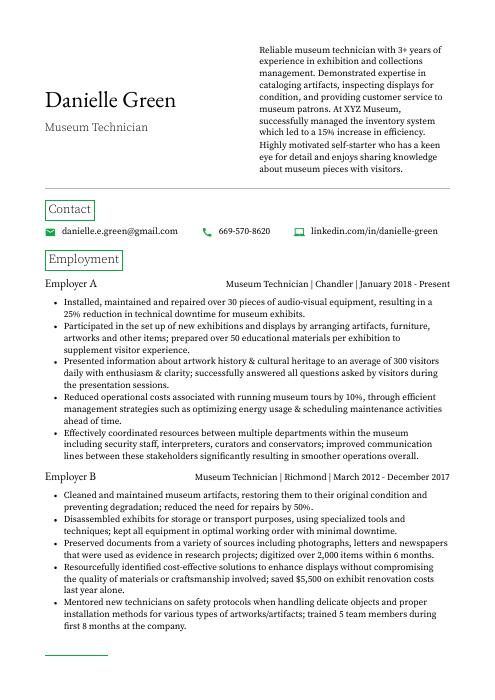 Quokka
Quokka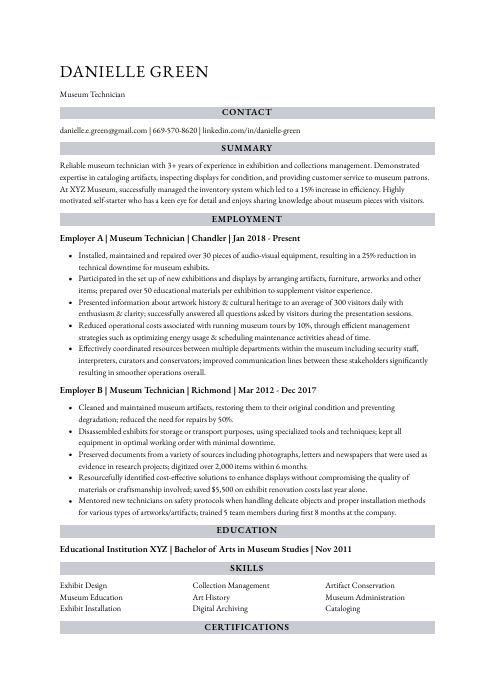 Numbat
Numbat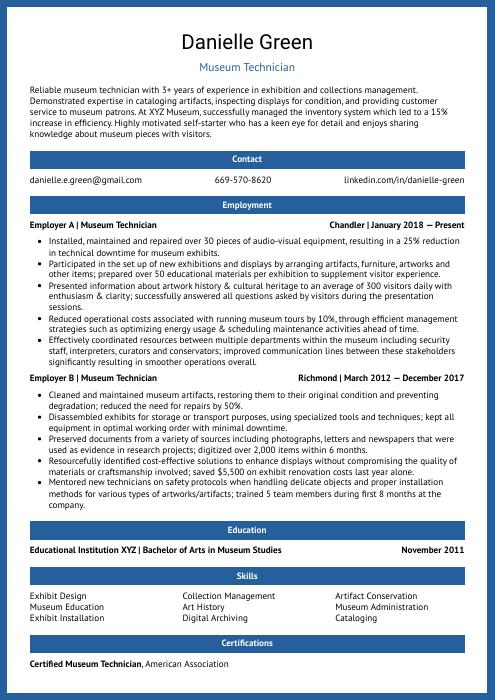 Ocelot
Ocelot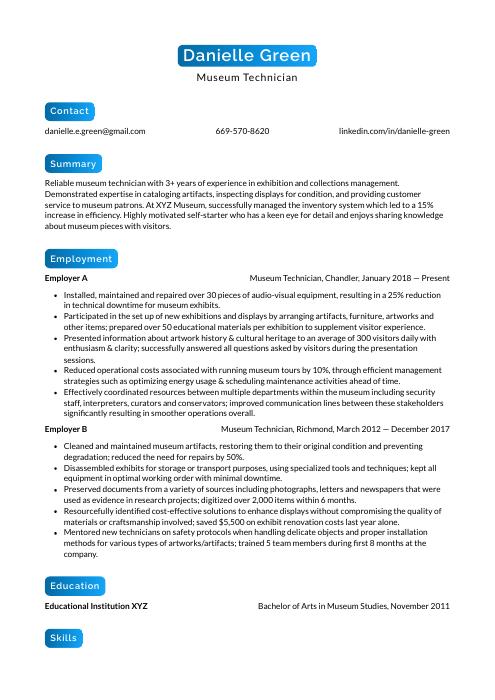 Kinkajou
Kinkajou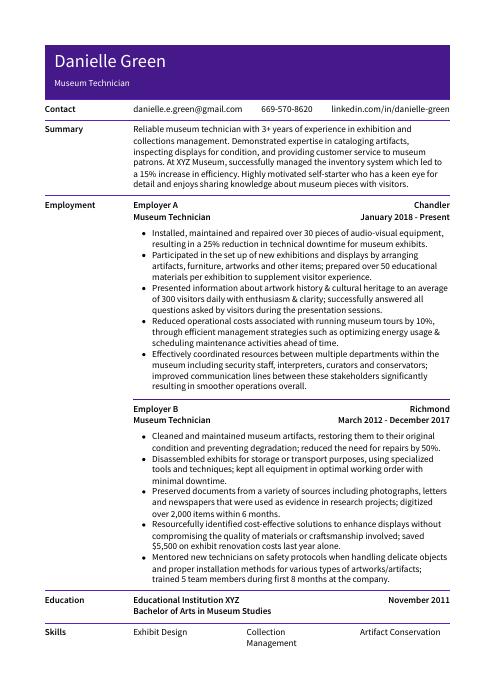 Pika
Pika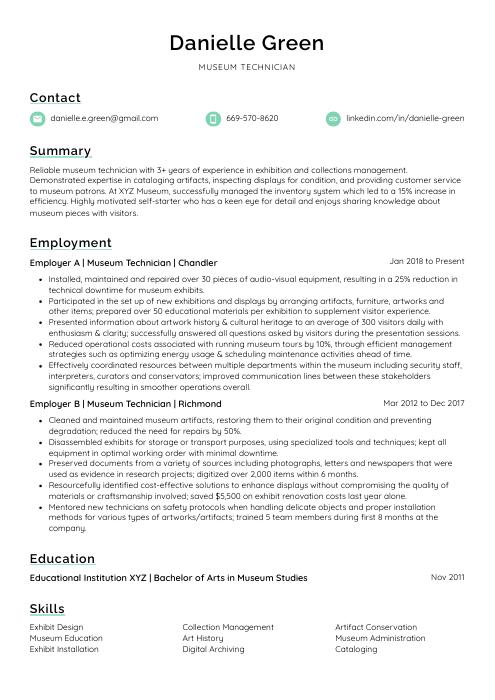 Lorikeet
Lorikeet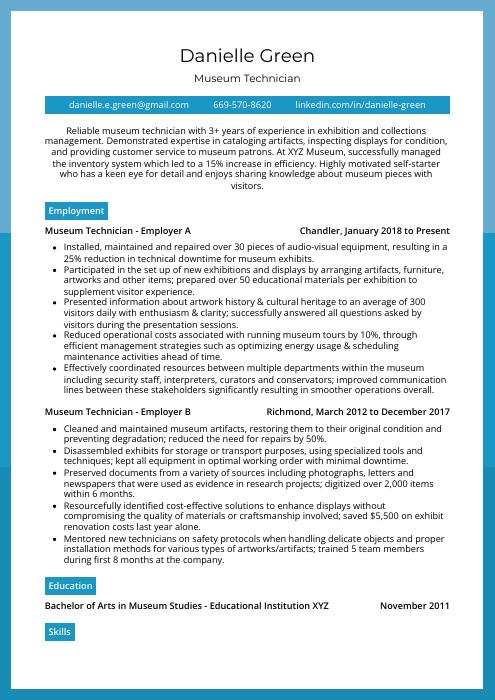 Rhea
Rhea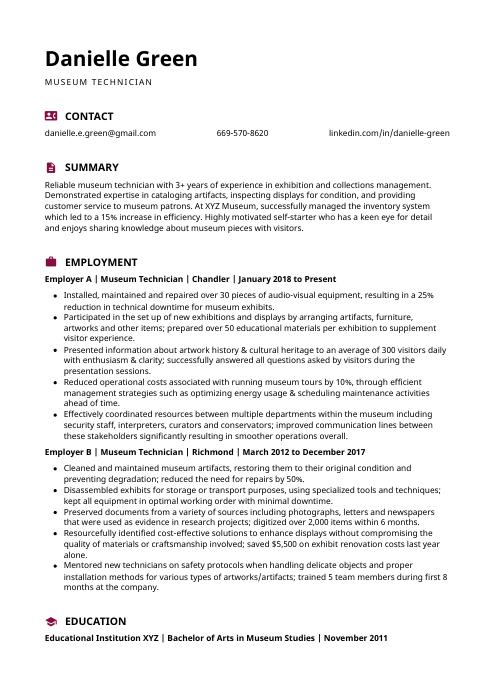 Hoopoe
Hoopoe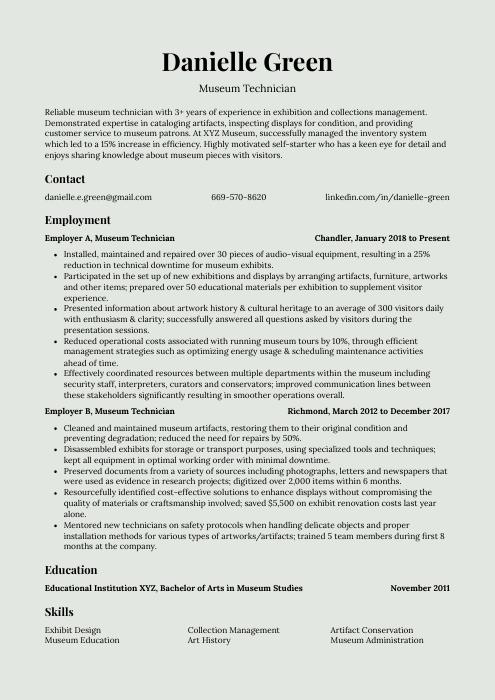 Saola
Saola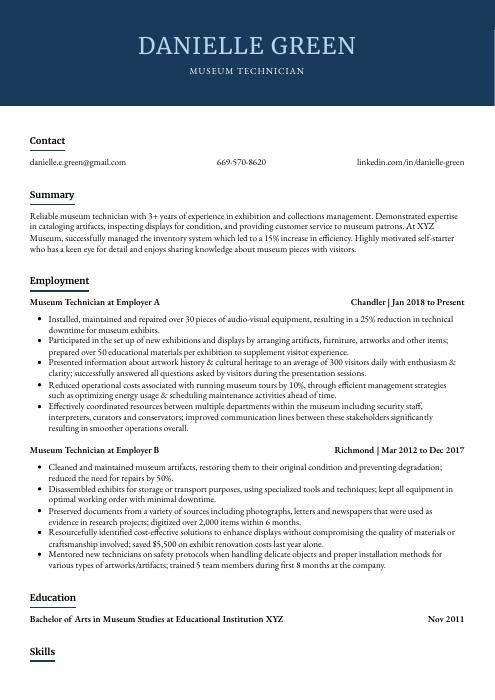 Bonobo
Bonobo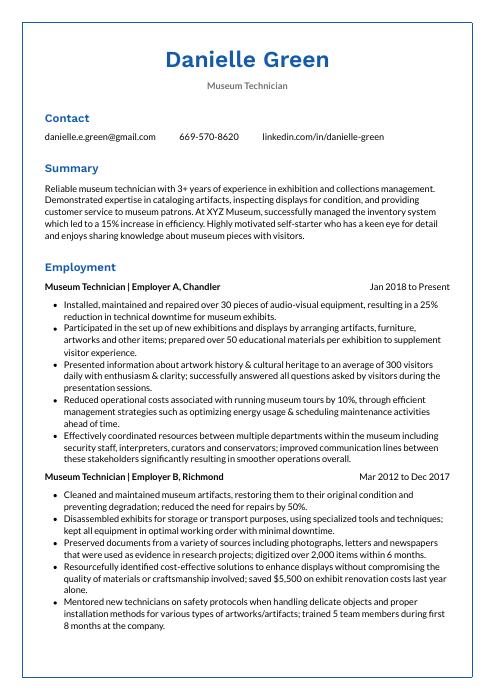 Markhor
Markhor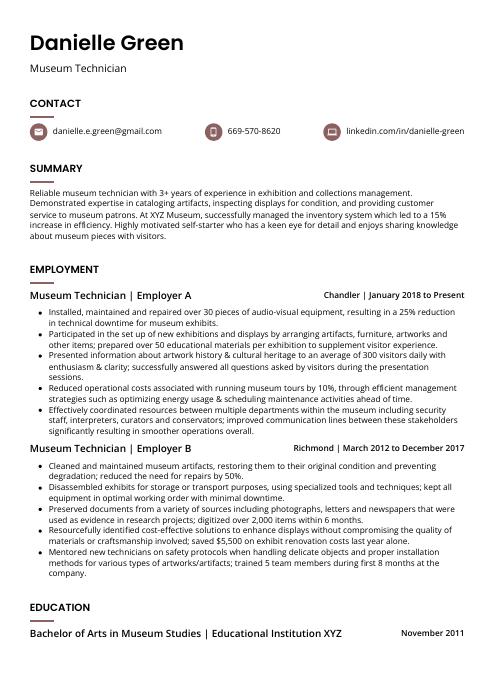 Fossa
Fossa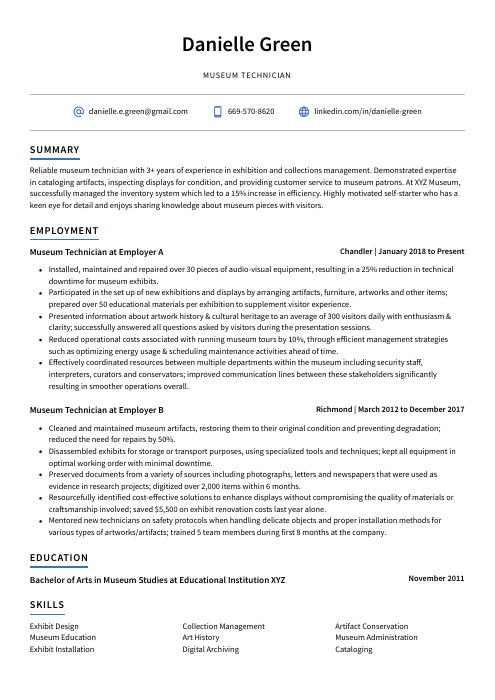 Axolotl
Axolotl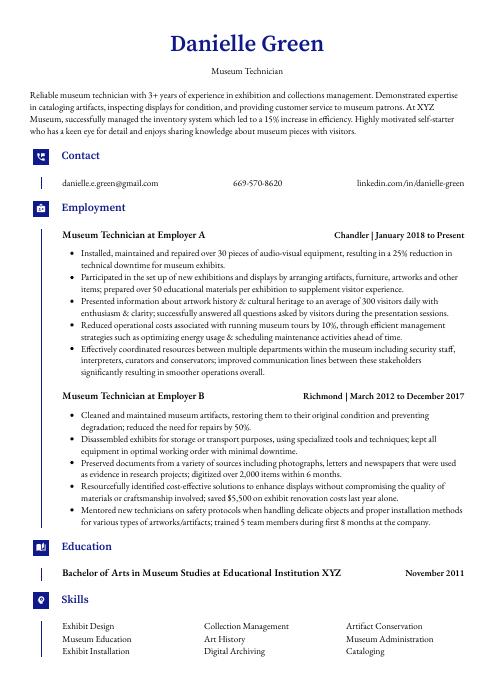 Gharial
Gharial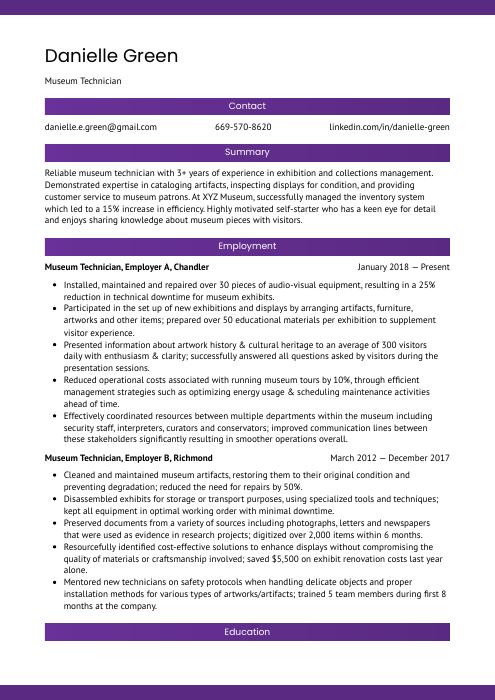 Jerboa
Jerboa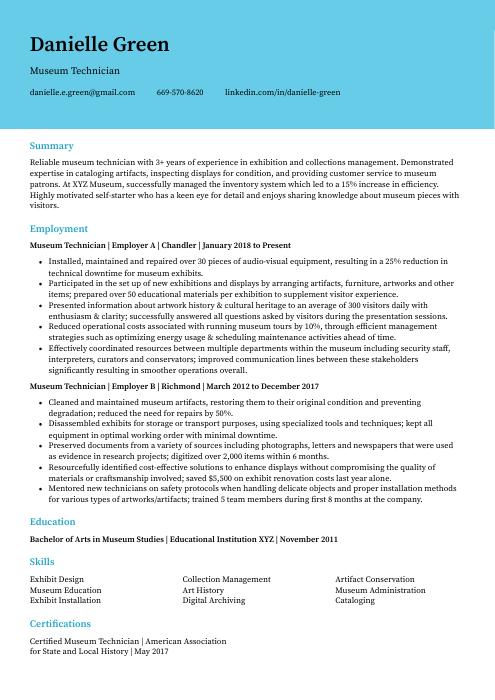 Dugong
Dugong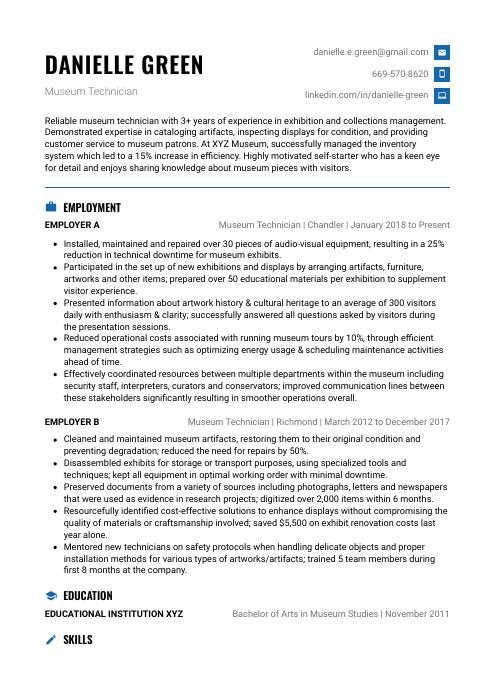 Echidna
Echidna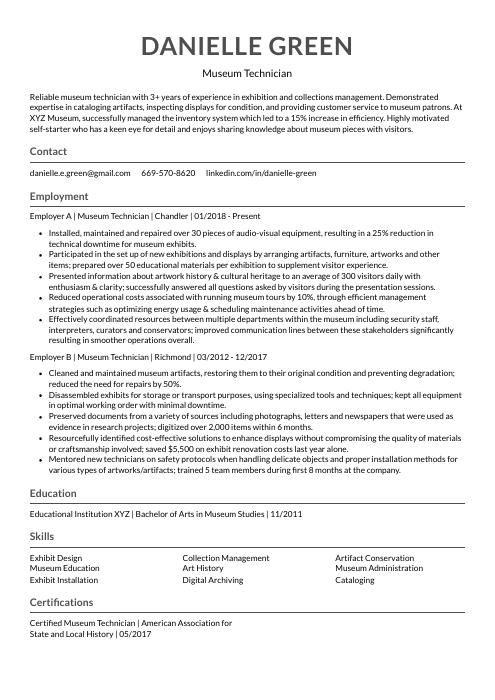 Indri
Indri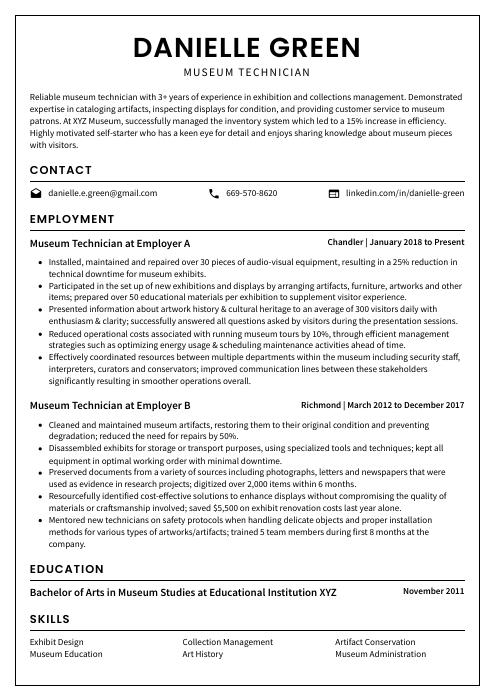 Cormorant
Cormorant Rezjumei
Rezjumei
